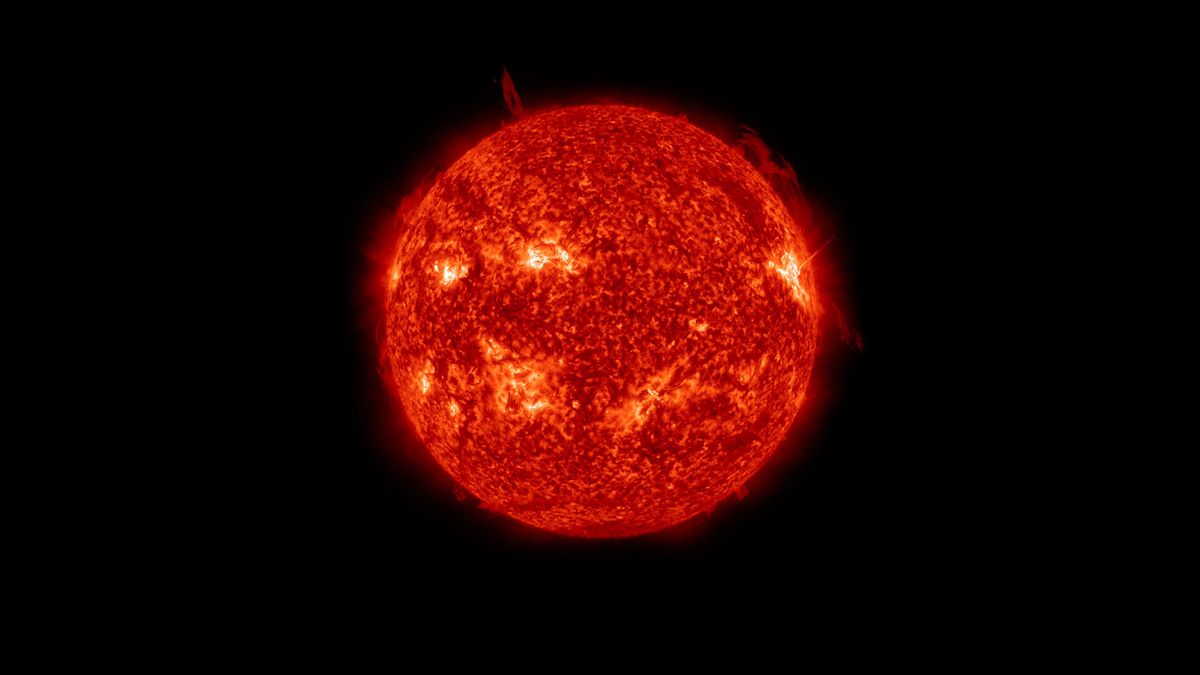Astronomers trying to measure the sun’s age by analyzing vibrations rippling within the sun have realized something troubling. It seems that the solar cycle of magnetic activity is meddling with their efforts. Of course, we can verify the sun’s true age through independent means — and we therefore know it’s about 4.6 billion years old — but this issue with vibrational measurements of stellar age threatens to thwart attempts to measure the fundamental characteristics of other stars.
We know the sun’s age because, for instance, scientists have managed to measure the radioactive decay of atoms in our solar system that formed alongside the planets and the sun. Radioactive decay refers to when the nucleus of an atom loses energy via radiation and decays into a more stable element. The rate of decay of a quantity of radioactive material is described as its half-life, which is the time taken for half of that quantity to decay, so we can backtrack and work out how old it is based on how much has decayed over time. Thus, by tracking the timeline of radioactive decay for atoms within our solar system, we can deduce the age of our solar system. In addition, scientists’ detailed models of stellar evolution are key in determining the sun’s age.
There’s also another way to determine the age of the sun, or any star for that matter. It’s called helioseismology when related to the sun, and asteroseismology when referring to other stars.
“You must imagine a star as a big ball of gas in constant motion,” said Jérôme Bétrisey of the University of Geneva in a statement. “Inside this star there are waves or pulsations that make it vibrate, rather like the sound that resonates in a musical instrument. These vibrations cause the star’s surface to move slightly and change luminosity regularly. Thanks to very precise instruments, we can detect these variations in luminosity.”
Related: Scientists collect high-resolution images of the North Star’s surface for 1st time
There are several different patterns, or modes, of oscillation overlapping in the sun, all with different periods and frequencies. And just as studying seismic waves on Earth can tell us about the interior of our planet as the tremors pass through, oscillations in the sun are informative of its interior structure. By comparing what those oscillations are telling us with detailed models of what the interior of the sun should look like at different ages, solar physicists can determine what age the sun currently is.
However, previous measurements have revealed discrepancies between solar age observations and theoretical models — and now, a team led by Bétrisey has shown that it’s probably the sun’s own magnetic activity that is at fault. This is surprising, because the consensus had previously been that magnetic activity should have no impact at all.
Bétrisey’s team looked at 26.5 years’ worth of data from two sun-observing programs. One was BISON, the Birmingham Solar Oscillations Network, which is a collection of ground-based solar observatories overseen by scientists at the University of Birmingham in the U.K. The other was GOLF, the Global Oscillations at Low Frequency instrument on the joint NASA–ESA SOHO (Solar and Heliospheric Observatory) mission that was launched in 1995.
Our sun undergoes an 11-year cycle of magnetic activity, rising from solar minimum when there are hardly any sunspots visible, to solar maximum when there are sunspots, prominences, coronal mass ejections and flares aplenty.
The BISON and GOLF data both showed a 6.5% difference when measuring the sun’s age via helioseismology at solar minimum compared to at solar maximum. Furthermore, of the two solar cycles encompassed by the 26.5 years’ worth of observations, both BISON and GOLF indicated that the cycle with stronger magnetic activity had a greater impact upon the discrepancy in the age measurement.
Because, in the grand scheme of things, the sun is not a very active star, the results from BISON and GOLF suggest that “the impact of magnetic activity could be very significant for more active stars such as those that PLATO will detect,” said Bétrisey.
PLATO, or the Planetary Transits and Oscillations of Stars, which is a forthcoming mission to be launched by the European Space Agency in 2026, will survey stars looking for dips in their light. Some of these dips will be caused by transiting exoplanets, but PLATO will also be able to detect dips in the luminosity of stars resulting from asteroseismic oscillations, from which astronomers should be able to determine vital stellar statistics including mass, radius and, indeed, age. Although the reason why magnetic activity can affect asteroseismic measurements is not yet clear, it must be taken into account for PLATO’s observations, while Bétrisey’s team also suggests that past measurements, such as those made with NASA’s Kepler Space Telescope, may also need revisiting.
As Bétrisey and colleagues describe it in their research paper, this is a “looming challenge” for the future of asteroseismology.
The findings were published on Aug. 8 in the journal Astronomy and Astrophysics.














/https://tf-cmsv2-smithsonianmag-media.s3.amazonaws.com/filer_public/d1/82/d18228f6-d319-4525-bb18-78b829f0791f/mammalevolution_web.jpg)






Discussion about this post